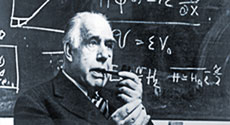Niels Bohr Lecture by Mark Lancaster
Title: Is new physics hiding in the magnetic interactions of a muon?
Abstract: The interaction of a muon’s spin with a magnetic field defines its magnetic moment in terms of the gyromagnetic ratio, g. In the Dirac equation, g is exactly 2, but additional higher order QED, electroweak and strong interactions increase its value by ~ 0.1%. Moreover, new interactions beyond the Standard Model of particle physics can also contribute at the level of approximately 1 part per million. Very precise measurements are thus required to uncover new, beyond the Standard Model, interactions.
I will describe the most recent, world's best, measurement, from the Fermilab Muon g-2 experiment: a measurement with a precision of 0.2 parts per million which is the most accurately measured quantity using a particle accelerator storage ring and the plans to improve this precision and the Standard Model calculation which will hopefully resolve whether the magnetic interaction of a muon is a harbinger of new physics or not.
About the speaker:
Mark Lancaster s a Professor of experimental particle physics at University of Manchester and previously University College London. His research career has been as part of large international experimental particle physics collaborations:
ZEUS (1988-1996), CDF (1996-2013), COMET (2008-2013), Muon g-2 (2013-) and Mu2e (2016-) and his research has been in three specific areas: precision measurements of W and Z bosons; elucidating the nature of the strong nuclear force and the structure of the proton; and most recently the precision measurement of the muon's magnetic moment and its rare decay modes.
He was the co-spokesperson of the Fermilab Muon g-2 experiment from 2018-2020. He was awarded the Chadwick Medal by the UK's Institute of Physics in 2021 and in 2023 elected as a Fellow of the Royal Society and the American Physical Society .
Coffee, tea and cake will be served outside Aud. 3 at 15:45
 Niels Bohr Lectures er en engelsk-sproget foredragsrække på Niels Bohr Institutet med kendte forskere fra hele verden.
Niels Bohr Lectures er en engelsk-sproget foredragsrække på Niels Bohr Institutet med kendte forskere fra hele verden.
Foredragene holdes cirka 10 gange om året og er offentlige. De er for studerende og ansatte ved Niels Bohr Institutet samt andre med interesse for at høre om videnskabelig forskning i verdensklasse. Foredragene holdes på et ikke-teknisk niveau, hvor de kan forstås af alle med en baggrundsviden, der svarer til de første år på fysikstudiet.
Tidspunkt og sted: Hvis intet andet er anført, finder foredragene sted kl. 15.15 i Margrethe Bohr Salen, Niels Bohr Bygningen, 2200 København N. Kaffe og kage serveres en halv time inden foredraget starter.
The lectures are public and held about 10 times a year. The lectures are for students and staff at the Niels Bohr Institute and others interested in worldwide scientific research. The lectures are held on a non-technical level where they can be understood by anyone with a background similar to the first year of physics study.
Time and place: Unless otherwise specified, the lectures take place at. 15.15 in Margrethe Bohr Salen, Niels Bohr Bygningen, 2200 Copenhagen N. Coffee and cake will be served half an hour before the lecture starts.
